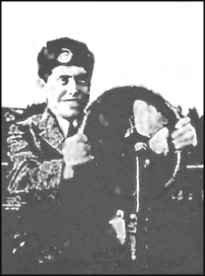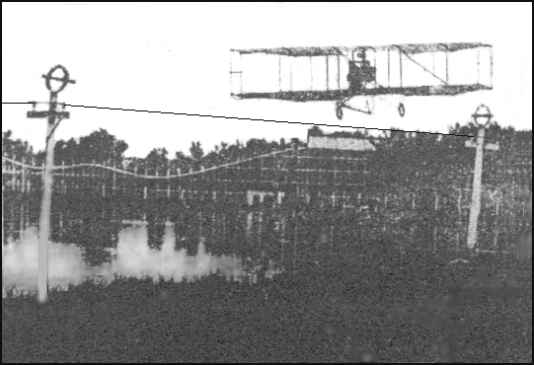
 |
DENVER, COLORADO. SATURDAY, AUGUST 5, 1911. -- 12 PAGES |
BUILDINGS IN DENVER-MADE MACHINE AS PEOPLE GASP |
 |
 |
Referred by Robert Moore, 1-9-06 |
|
It." Says Expert of Thomp- son Lakeside Flight. "There is not another aviator in the country who would ever attempt such a flight." Thus spoke J. F. Helpling, a Los Angeles aviator, who has been present at every large aviation meeting in this country and many in Europe, after witnessing the fourteen minute flight of George W. Thompson, a Denver man, yesterday afternoon in a Mathewson biplane, Denver-built, at Lakeside park. And every one of the spectators who had watched with bated breath the quiet, unassuming little birdman literally graze death a dozen times while he was in the air, echoed the sentiment. From the time the bi-plane rose after a run of only 400 feet over a soft field, jumped the electric light wires, fell to within five feet of the water of the lake, recovered and circled the lake twice and soared away toward Arvada, until Thompson brought his car to earth on the old Jefferson county fair grounds, there was not a minute that the crowd did not expect the biplane to dash into a tree, wire or building and fall. FIELD NOT WELL ADAPTED Manager Frank Burt had put the fiield into as good condition as possible in the limited time allowed since the contract was made for the flights, but it is not well adpated for an aviation field and the prediction was freely made yesterday afternoon that Thompson would not attempt a flight. There is a run of only 400 feet from the fence to the lake and around the lake are stretched electric light wires. The surface of the field was soft and in places sandy, making it difficult for the aviator to attain a speed sufficient to rise from the ground in the restricted space. MOTOR MISSING EXPLOSIONS When the time came for the 4 o'clock flight it was found that the seventy horsepower motor was missing explosions and it was not until a few minutes before 7 that the aviator and mechanic deemed it in order to attempt a flight. Then the machine was taken from the hangar and rolled up to the end of the field. Thompson wasted very little time in preliminaries. After testing his motor for a few seconds he started down the field. Slowly the big biplane began to roll forward, but soon gathered momentum. Few of the spectators, however, expected to see the birdman attempt to leave the ground. They were certain he would shut off the motor and make another start. RISE AT EDGE OF LAKE But apparently almost at the edge of the lake the front wheels left the ground. For a space of five feet the rear wheel dragged and then the machine rose at a sharp angle and seemingly jumped over the wires. Before Thompson could recover, he was within five feet of the surface of the water and it seemed certain he would plunge into the lake. With rare skill and marvelous coolness, however, he succeeded in pointing the plane upward and the machine slowly began to climb. By the time he was so close to the wires and building on the opposite side of the lake, that it was impossible to rise sufficiently to clear them and again it seemed the aviator must certainly be dashed to pieces, but with a deft turn of the wheel, he veered to the left to get room and then swung to the right in so short an arch that he seemed to be turning on a pivot. |
CROWDS WITH DENVER MACHINE |
 |
|
He then circled the lake over the water, gradually attaining altitude until he rose above the wires and swung in between the boathouse
and the Japanese tea garden. There was barely five feet between the broad planes and the building on either side. The scenic
railway structure menaced him ahead. So low that the aeroplane was obscured from the view of the spectators on the aviation field by the buildings, the aviator steered between the buildings over the heads of the throng, many of whom ducked and ran, thinking the machine was about to fall. He then circled the lake again and with an upward tilt soared away toward Arvada. Sailing over Arvada he veered and circled inspiration point, returning over the park and waving to the cheering spectators. Barely missing the tops of the tall trees, he sped at more than a mile a minute torward Wheatridge and could be seen skimming along over the valley and apparently dodging in and out among the trees. Again he made the circuit of Inspiration Point. The sounds of the explosions showed that the motor was again missing and it was seen that the aviator had difficulty in climbing. But without pause he again passed over the park, sailing as smoothly as a bird. LEAVES BRUSH THE PLANE He sailed out toward Wheatridge and returning passed between two lofty trees so close together that the leaves brushed the plane on each side. He was headed for the starting point, but directly ahead were several lines of telephone wires and the biplane with a crippled motor, refused to climb fast enough to clear them. Thompson, seeing that it was impossible to regain his starting point, turned again and passing over some wires, clearing them by barely three feet, landed easily in the middle of the old race track, just outside the park. Yesterday's flight showed conclusively that the Mathewson biplane could fly in this altitude and fly fast. It also demonstrated that it answers the steering wheel readily and quickly and that it can be turned in a very small circle. It is intended for speed and not for altitude and more than fufills the promises of the manufacturer. The flight yesterday also demonstrated conclusively that Thompson is entitled to rank among the very foremost aviators of the world. He has nerves of steel, a cool head and a thorough knowledge of his machine. He is resourceful and time and again, extricated himself from positions which would have meant disaster to a majority of the men who hazard their lives in the air. There will be two flights today, one at 4 and the other at 7 o'clock. The start will be made from the field where the biplane landed yesterday. Manager Burt will have the ground scraped and prepared this morning and with any kind of favorable weather made sensational work maybe expected. Tomorrow there will be the last two flights at the same hours, and it is expected that thousands will visit the park on both days. The fact that the Mathewson biplane is manufactured in Denver and holds its own with the crack aeroplances of this country and Europe adds additional interest to the present meet. There is little about George W. Thompson to suggest the daredevil birdman he proved himself yesterday. Small of stature, quiet and almost diffident, he would be mistaken for a rather timid yound man who was inclined to avoid notoriety. It is known that the name Thompson is assumed simply as a professional designation and not even the birdman's intimate professionsal friends know his real name. His reason for going under an assumed name is that he has an aged mother, who, if she knew that her only son was daily risking his life in the air, would collapse under the strain. For this reason he has never let her learn the character of his occupation. |
via email from Barbara Lewellyn, 2-4-06 Yes, the story was rather graphic. The newspapers from the early part of the 20th century are all like this. Graphic photos of auto accidents, murders, auto-pedestrian accidents, etc... There was one article I did not copy which described how the fans from the stands in Lamar swarmed around George's downed aircraft and took parts of the airplane as souvenirs. It took about five minutes to establish order and push the crowd back. There was difficulty in removing George from the wreckage because his feet were tangled in the bicycle part of the plane. When it became obvious that George was seriously injured he was laid on a mattress next to his downed plane. He died an hour later. Lamar was still a cow town in the 1910s so I suppose they didn't have a hospital to take him to. I do all my research at the University of Colorado Norlin Library in Boulder. The media room has a complete set of microfilm for both the Rocky Mountain News and the Denver Post going back to their very beginnings in 1859 and 1895 respectively. If you ever need any other aviation news just let me know. Since I'm already there doing genealogy research it is not out of my way to look at another microfilm reel. |


|